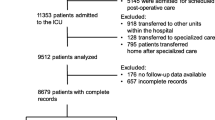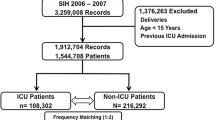Abstract
Purpose
To identify factors influencing triage decisions and investigate whether admission to the intensive care unit (ICU) could reduce mortality compared with treatment on the ward.
Methods
A multicentre cohort study in 11 university hospitals from seven countries, evaluating triage decisions and outcomes of patients referred for admission to ICU who were either accepted, or refused and treated on the ward. Confounding in the estimation of the effect of ICU admission on mortality was controlled by use of a propensity score approach, which adjusted for the probability of being admitted. Variability across centres was accounted for in both analyses of factors influencing ICU admission and effect of ICU admission on mortality.
Results
Eligible were 8,616 triages in 7,877 patients referred for ICU admission. Variables positively associated with probability of being admitted to ICU included: ventilators in ward; bed availability; Karnofsky score; absence of comorbidity; presence of haematological malignancy; emergency surgery and elective surgery (versus medical treatment); trauma, vascular involvement, liver involvement; acute physiologic score II; ICU treatment (versus ICU observation). Multiple triages during patient’s hospital stay and age were negatively associated with ICU admission. The area under the receiver operating characteristic (ROC) curve of the model was 0.83 [95% confidence interval (CI): 0.81–0.84], with Hosmer–Lemeshow test P = 0.300. ICU admission was associated with a statistically significant reduction of both 28-day mortality [odds ratio (OR): 0.73; 95% CI: 0.62–0.87] and 90-day mortality (0.79; 0.66–0.93). The benefit of ICU admission increased substantially in patients with greater severity of illness.
Conclusions
We suggest that intensivists take great care to avoid ICU admission of patients judged not severe enough for ICU or with low performance status, and they tend to admit surgical patients more readily than medical patients. Interestingly, they do not judge age per se as a reason for refusal of ICU admission. Admission to ICU was associated with a reduction of both 28- and 90-day mortality, particularly in patients with greater severity of illness at time of triage.


Similar content being viewed by others
References
Sparkes DJ, Smith GB, Prytherch D (2004) Intensive care requirements for an ageing population—a microcosm of problems facing the NHS? Clin Med 4:263–266
Boumendil A, Somme D, Garrouste-Orgeas M, Guidet B (2007) Should elderly patients be admitted to intensive care unit? Intensive Care Med 35:192–194
Demoule A (2009) Non-invasive ventilation: how far away from the ICU? Intensive Care Med 35:192–194
Frisho-Lima P, Gurman G, Schapira A, Porath A (1994) What happens to patients who are not admitted? Theor Surg 9:208–211
Metcalfe MA, Sloggett A, McPherson K (1997) Mortality among appropriately referred patients refused admission to intensive-care units. Lancet 350:7–11
Sprung CL, Geber D, Eidelman LA, Baras M, Pizov R, Nimrod A, Oppenheim A, Epstein L, Cotev S (1999) Evaluation of triage decisions for intensive care admission. Crit Care Med 27:1073–1079
Joynt GM, Gomersall CD, Tan P, Lee A, Cheng CA, Wong EL (2001) Prospective evaluation of patients refused admission to an intensive care unit: triage, futility and outcome. Intensive Care Med 27:1459–1465
Simchen E, Sprung CL, Galai N, Zitser-Gurevich Y, Bar-Lavi Y, Gurman G, Klein M, Lev A, Levi L, Zveibil F, Mandel M, Mnatzaganian G (2004) Survival of critically ill patients hospitalized in and out of intensive care units under paucity of intensive care unit beds. Crit Care Med 32:1654–1661
Simchen E, Sprung CL, Galai N, Zitser-Gurevich Y, Bar-Lavi Y, Levi L, Zveibil F, Mandel M, Mnatzaganian G, Goldschmidt N, Ekka-Zohar A, Weiss-Salz I (2007) Survival of critically ill patients hospitalized in and out of intensive care. Crit Care Med 35:449–457
Walter KL, Siegler M, Hall JB (2008) How decisions are made to admit patients to medical intensive care units (MICUs): a survey of MICU directors at academic medical centers across the United States. Crit Care Med 36:414–420
Azoulay E, Pochard F, Chevret S, Vinsonneau C, Garrouste M, Cohen Y, Thuong M, Paugam C, Apperre C, De Cagny B, Brun F, Bornstain C, Parrot A, Thamion F, Lacherade JC, Bouffard Y, Le Gall JR, Herve C, Grassin M, Zittoun R, Schlemmer B, Dhainaut JF, PROTOCETIC Group (2001) Compliance with triage to intensive care recommendations. Crit Care Med 29:2132–2136
Fan E, Needham DM (2007) Deciding who to admit to a critical care unit. BMJ 335:1103–1104
Sinuff T, Kahnamoui K, Cook DJ, Luce JM, Levy MM, Values ethics and rationing in critical care task force (2004) Rationing critical care beds: a systematic review. Crit Care Med 32:1588–1597
Garrouste-Orgeas M, Montuclard L, Timsit JF, Misset B, Christias M, Carlet J (2003) Triaging patients to the ICU: a pilot study of factors influencing admission decisions and patient outcomes. Intensive Care Med 29:774–781
Garrouste-Orgeas M, Montuclard L, Timsit JF, Reignier J, Desmettre T, Karoubi P, Moreau D, Montesino L, Duguet A, Boussat S, Ede C, Monseau Y, Paule T, Misset B, Carlet J, French ADMISSIONREA Study Group (2005) Predictors of intensive care unit refusal in French intensive care units: a multiple-center study. Crit Care Med 33:750–755
Task Force of the American College of Critical Care Medicine, Society of Critical Care Medicine (1999) Guidelines for intensive care unit admission, discharge, and triage. Crit Care Med 27:633–638
Karnofsky D, Abelmann W, Craver L et al (1948) The use of nitrogen mustards in the palliative treatment of carcinoma. Cancer 1:634–656
Le Gall JR, Lemeshow S, Saulnier F (1993) A new simplified acute physiology score (SAPS II) based on a European/North American multicenter study. JAMA 270:2957–2963
Iapichino G, Morabito A, Mistraletti G, Ferla L, Radrizzani D, Reis Miranda D (2003) Determinants of post-intensive care mortality in high-level treated critically ill patients. Intensive Care Med 29:1751–1756
Rosenbaum P (1989) Optimal matching for observational studies. J Am Stat Assoc 84:1024–1032
Hubbard RE, Lyons RA, Woodhouse KW, Hillier SL, Wareham K, Ferguson B, Major E (2003) Absence of ageism in access to critical care: a cross-sectional study. Age Ageing 32:382–387
Iapichino G, Radrizzani D, Pezzi A, Assi E, Di Mauro P, Mistraletti G, Porta F (2005) Evaluating daily nursing use and needs in the intensive care unit: a method to assess the rate and appropriateness of ICU resource use. Health Policy 73:228–234
Iapichino G, Radrizzani D, Rossi C, Pezzi A, Anghileri A, Boffelli S, Giardino M, Mistraletti G, Bertolini G, GiViTI Group (2007) Proposal of a flexible structural-organizing model for the intensive care units. Minerva Anestesiol 73:501–506
Iapichino G, Radrizzani D, Simini B, Rossi C, Albicini M, Ferla L, Colombo A, Pezzi A, Brazzi L, Melotti R, Rossi G, Italian group for the evaluation of interventions in intensive care medicine (2004) Effectiveness and efficiency of intensive care medicine: variable costs in different diagnosis groups. Acta Anaesthesiol Scand 48:820–826
Lecuyer L, Chevret S, Thiery G, Darmon M, Schlemmer B, Azoulay E (2007) The ICU trial: a new admission policy for cancer patients requiring mechanical ventilation. Crit Care Med 35:808–814
Reis Miranda D, Nap R (2006) The age of the elderly. Neth J Crit Care 10:621–624
Acknowledgments
Supported by the European Commission contract QLK-CT-2002-00251, the European Society of Intensive Care Medicine, The Israel National Institute for Health Policy and Health Services Research grant number 1998/11/G and by Red GIRA G03/063. We thank Prof. Dinis Reis Miranda for his invaluable help in reviewing the manuscript.
Author information
Authors and Affiliations
Corresponding author
Electronic supplementary material
Below is the link to the electronic supplementary material.
Appendix
Appendix
Investigators: Denmark: Herlev University Hospital (A), Copenhagen (A Lippert, J Wiis, A Christensen);
France: Lariboisiere Hospital (B), Paris (D Payen, R Pirracchio);
Israel: Hadassah Medical Organization (C), Jerusalem (C. Sprung, L Trapido, D Krojanker, P Levin); Soroka Medical Center (D), Beersheba (G Gurman);
Italy: San Paolo University Hospital (E), Milan (G Iapichino, A Pezzi); San Gerardo University Hospital (F), Monza (A Pesenti, M Cormio, N Patroniti);
The Netherlands: Isala Hospital (G), Zwolle (J Bakker, M Hoogendoorn, N v Rijn); University Medical Center (H), Utrecht (J Kesecioglu, J Nijdeken, M Bruens);
Spain: Sabadell Hospital, Corporació Sanitaria Parc Tauli (I), Sabadell (A Artigas, M Maluenda, G Goma);
The UK: Royal Hallamshire Hospital (L), Sheffield (D Edbrooke, C Minelli, GH Mills, S Smith); Whittington Hospital (M), University College of London, London (S Cohen, C Hargreaves, P Meale).
Steering Committee: C. Sprung (Chairman); Y. Brick, D. Edbrooke, M. Sonnenblick, G. Van Steendam.
Study Coordinating Center: C. Sprung (Physician Coordinator); J. Sinclair-Cohen, L. Trapido (Research Coordinators); A. Avidan, E. Ludmir, J. Kabiri, K. Furmanov, B. Hain, O. Kalugin, D Krojanker, P Levin, I. Zack.
Rights and permissions
About this article
Cite this article
Iapichino, G., Corbella, D., Minelli, C. et al. Reasons for refusal of admission to intensive care and impact on mortality. Intensive Care Med 36, 1772–1779 (2010). https://doi.org/10.1007/s00134-010-1933-2
Received:
Accepted:
Published:
Issue Date:
DOI: https://doi.org/10.1007/s00134-010-1933-2




